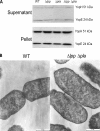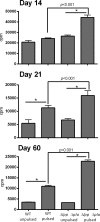Deletion of Braun lipoprotein and plasminogen-activating protease-encoding genes attenuates Yersinia pestis in mouse models of bubonic and pneumonic plague
- PMID: 24686064
- PMCID: PMC4019162
- DOI: 10.1128/IAI.01595-13
Deletion of Braun lipoprotein and plasminogen-activating protease-encoding genes attenuates Yersinia pestis in mouse models of bubonic and pneumonic plague
Abstract
Currently, there is no FDA-approved vaccine against Yersinia pestis, the causative agent of bubonic and pneumonic plague. Since both humoral immunity and cell-mediated immunity are essential in providing the host with protection against plague, we developed a live-attenuated vaccine strain by deleting the Braun lipoprotein (lpp) and plasminogen-activating protease (pla) genes from Y. pestis CO92. The Δlpp Δpla double isogenic mutant was highly attenuated in evoking both bubonic and pneumonic plague in a mouse model. Further, animals immunized with the mutant by either the intranasal or the subcutaneous route were significantly protected from developing subsequent pneumonic plague. In mice, the mutant poorly disseminated to peripheral organs and the production of proinflammatory cytokines concurrently decreased. Histopathologically, reduced damage to the lungs and livers of mice infected with the Δlpp Δpla double mutant compared to the level of damage in wild-type (WT) CO92-challenged animals was observed. The Δlpp Δpla mutant-immunized mice elicited a humoral immune response to the WT bacterium, as well as to CO92-specific antigens. Moreover, T cells from mutant-immunized animals exhibited significantly higher proliferative responses, when stimulated ex vivo with heat-killed WT CO92 antigens, than mice immunized with the same sublethal dose of WT CO92. Likewise, T cells from the mutant-immunized mice produced more gamma interferon (IFN-γ) and interleukin-4. These animals had an increasing number of tumor necrosis factor alpha (TNF-α)-producing CD4(+) and CD8(+) T cells than WT CO92-infected mice. These data emphasize the role of TNF-α and IFN-γ in protecting mice against pneumonic plague. Overall, our studies provide evidence that deletion of the lpp and pla genes acts synergistically in protecting animals against pneumonic plague, and we have demonstrated an immunological basis for this protection.
Figures













Similar articles
-
Combinational deletion of three membrane protein-encoding genes highly attenuates yersinia pestis while retaining immunogenicity in a mouse model of pneumonic plague.Infect Immun. 2015 Apr;83(4):1318-38. doi: 10.1128/IAI.02778-14. Epub 2015 Jan 20. Infect Immun. 2015. PMID: 25605764 Free PMC article.
-
Further characterization of a highly attenuated Yersinia pestis CO92 mutant deleted for the genes encoding Braun lipoprotein and plasminogen activator protease in murine alveolar and primary human macrophages.Microb Pathog. 2015 Mar;80:27-38. doi: 10.1016/j.micpath.2015.02.005. Epub 2015 Feb 16. Microb Pathog. 2015. PMID: 25697665 Free PMC article.
-
Deletion of the Braun lipoprotein-encoding gene and altering the function of lipopolysaccharide attenuate the plague bacterium.Infect Immun. 2013 Mar;81(3):815-28. doi: 10.1128/IAI.01067-12. Epub 2012 Dec 28. Infect Immun. 2013. PMID: 23275092 Free PMC article.
-
Yersinia pestis and pneumonic plague: Insight into how a lethal pathogen interfaces with innate immune populations in the lung to cause severe disease.Cell Immunol. 2024 Sep-Oct;403-404:104856. doi: 10.1016/j.cellimm.2024.104856. Epub 2024 Jul 10. Cell Immunol. 2024. PMID: 39002222 Review.
-
Immune defense against pneumonic plague.Immunol Rev. 2008 Oct;225:256-71. doi: 10.1111/j.1600-065X.2008.00674.x. Immunol Rev. 2008. PMID: 18837787 Free PMC article. Review.
Cited by
-
Identification of New Virulence Factors and Vaccine Candidates for Yersinia pestis.Front Cell Infect Microbiol. 2017 Oct 17;7:448. doi: 10.3389/fcimb.2017.00448. eCollection 2017. Front Cell Infect Microbiol. 2017. PMID: 29090192 Free PMC article.
-
Progress on the research and development of plague vaccines with a call to action.NPJ Vaccines. 2024 Sep 7;9(1):162. doi: 10.1038/s41541-024-00958-1. NPJ Vaccines. 2024. PMID: 39242587 Free PMC article. Review.
-
Combinational deletion of three membrane protein-encoding genes highly attenuates yersinia pestis while retaining immunogenicity in a mouse model of pneumonic plague.Infect Immun. 2015 Apr;83(4):1318-38. doi: 10.1128/IAI.02778-14. Epub 2015 Jan 20. Infect Immun. 2015. PMID: 25605764 Free PMC article.
-
Escherichia coli Braun Lipoprotein (BLP) exhibits endotoxemia - like pathology in Swiss albino mice.Sci Rep. 2016 Oct 4;6:34666. doi: 10.1038/srep34666. Sci Rep. 2016. PMID: 27698491 Free PMC article.
-
Interplay between Peptidoglycan Biology and Virulence in Gram-Negative Pathogens.Microbiol Mol Biol Rev. 2018 Sep 12;82(4):e00033-18. doi: 10.1128/MMBR.00033-18. Print 2018 Dec. Microbiol Mol Biol Rev. 2018. PMID: 30209071 Free PMC article. Review.
References
-
- World Health Organization. 2006. Interregional meeting on prevention and control of plague, Antanarivo, Madagascar, 1 to 11 April. World Health Organization, Geneva, Switzerland: http://www.who.int/csr/resources/publications/WHO_HSE_EPR_2008_3w.pdf
Publication types
MeSH terms
Substances
Grants and funding
LinkOut - more resources
Full Text Sources
Other Literature Sources
Medical
Research Materials

